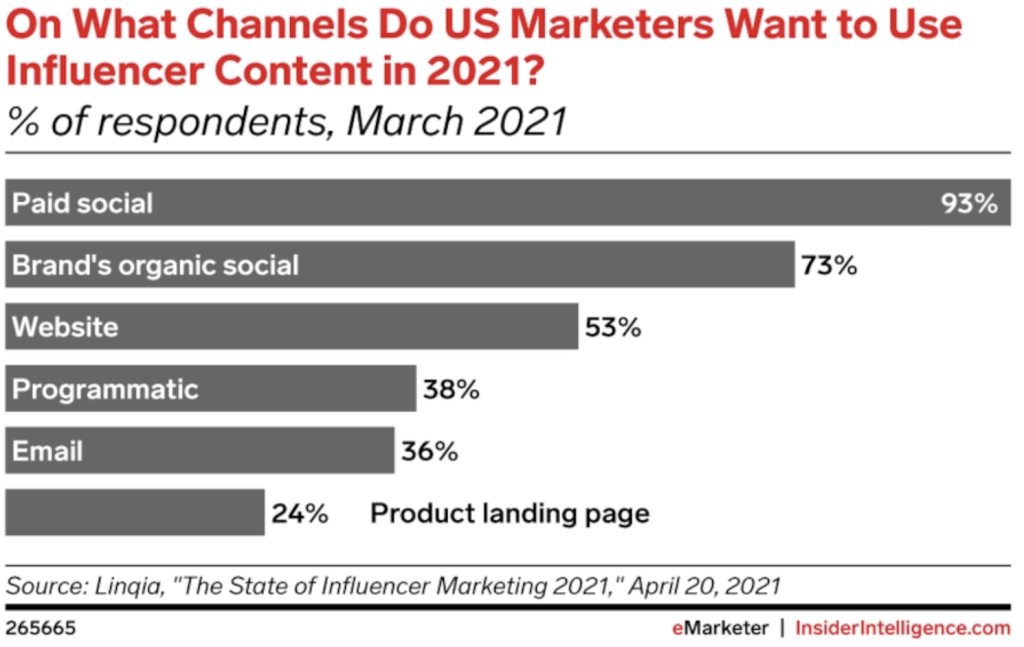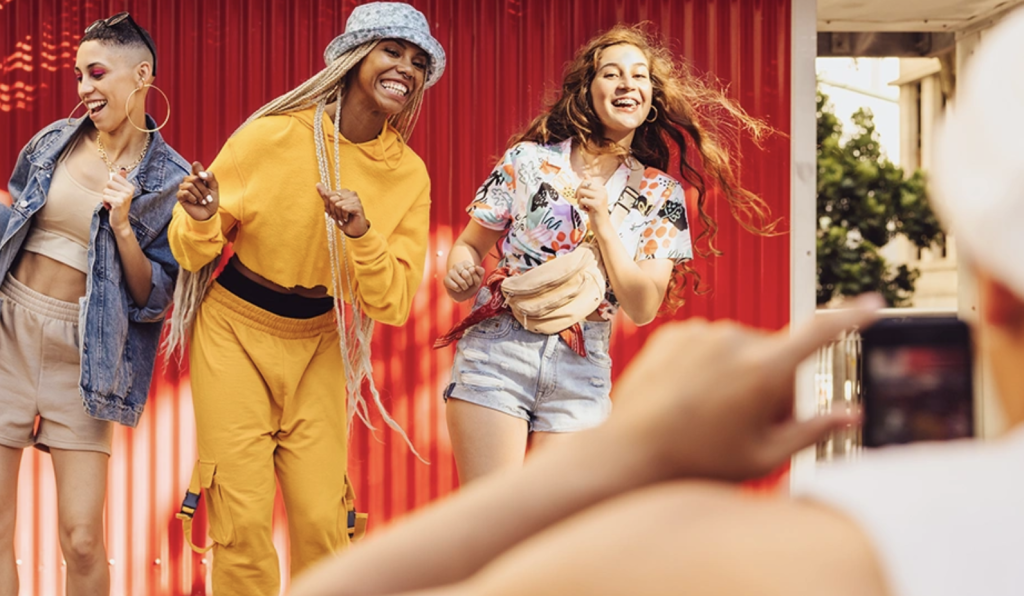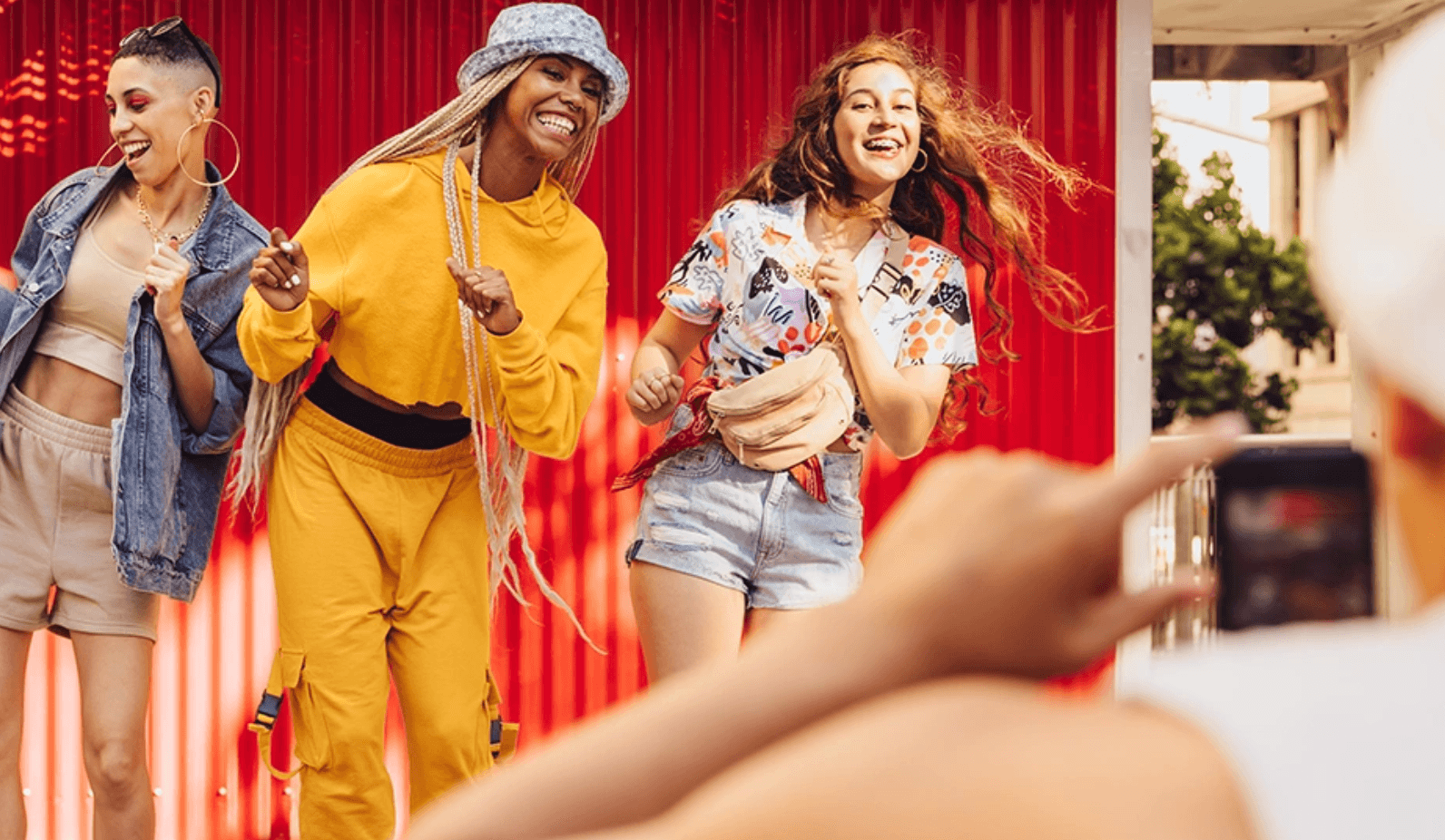Influencer Content Whitelisting. Everything You Need to Know!
- •Understanding Influencer Content Whitelisting
- •Clarifying the Terms: Whitelisting vs. Allowlisting in Influencer Marketing
- •How Influencer Whitelisting Operates
- •The Importance of Trust in Creator Licensing
- •Essential Terms and Definitions in Influencer Content Licensing Influencer Organic Posting
- •The Do’s and Don’ts of Handling Content Rights in Influencer Partnerships
- •Navigating the Complexities of Influencer Content Licensing
Influencer marketing has rapidly become a significant strategy, and the advent of content whitelisting by influencers introduces an even more effective tool to boost returns on digital marketing investments. So, what’s this all about?
Bar graph of “Preferred Channels for Influencer Content by US Marketers in 2021” Image courtesy of eMarketer

The concept of influencer content whitelisting represents a novel blend of organic and paid media strategies. Organic posts by influencers on their social channels continue to engage audiences effectively, while paid social initiatives provide richer data insights. On the flip side, targeted paid advertisements that connect directly with ideal consumers using tailored messages and calls to action give influencers more freedom to innovate.
Understanding Influencer Content Whitelisting
Influencer content whitelisting takes place when influencers allow brands to use their social media accounts for advertising purposes.
This process typically benefits both the influencer and the brand. Through targeted social advertisements, brands can access audiences known to be receptive to their content, and influencers are introduced to broader audiences.
Ecommerce brands see an improvement in their ROI from influencer collaborations and digital advertising efforts. Influencers, in turn, enjoy a boost in follower engagement. Feedback from these strategies has been exceptionally favorable.
Clarifying the Terms: Whitelisting vs. Allowlisting in Influencer Marketing
The terms influencer whitelisting and allowlisting refer to the same process. This technique has been known by various names, such as:
Creator endorsement Creator collaboration Influencer branding Amplification through paid media Access to creator advertising The industry is moving away from “whitelisting” towards more inclusive terminology. “Creator licensing” is now preferred, as promoted by GRIN and other influencer economy leaders.
See Also: Transitioning from Influencer Whitelisting to Embracing Creator Licensing
How Influencer Whitelisting Operates
On platforms like Facebook and Instagram, creator licensing (or influencer whitelisting) enables a brand to take over a creator’s Facebook Ads Manager for ad purposes. Since Facebook Ads Manager controls advertisements on both Facebook and Instagram, this turns creator posts into sponsored content on these platforms.
TikTok is also introducing its own creator licensing features, which differ slightly from those of Meta.
Although not as straightforward, a similar process can be manually executed on YouTube.
Understanding the intricacies of creator licensing is crucial as it’s a relatively fresh concept. It’s beneficial for both influencers and brands to grasp the fundamental aspects of licensing agreements, terminology, and principles.
The Importance of Trust in Creator Licensing
Currently, entering a licensing agreement can be daunting for creators. Success in these partnerships hinges on trust. Both parties, brands and influencers, must feel secure to engage in such collaborations.
As brands enhance their proficiency in managing relationships with creators, their capacity to foster trust with top influencers also increases. Conversely, as influencers accumulate experience in working with brands, their confidence in engaging in licensing agreements is likely to grow.

Essential Terms and Definitions in Influencer Content Licensing Influencer Organic Posting
Creators on social media platforms such as Instagram, YouTube, Facebook, Pinterest, LinkedIn, Twitch, or TikTok engage with their audience by posting content that reflects shared interests, values, and lifestyles. These posts are organic, meaning they do not involve any advertising expenditure or pay-per-click (PPC) mechanisms, and are distinguished from paid reach in digital marketing terminology.
Paid Social Media/Branded Social Ads
This encompasses all pay-per-click (PPC) advertising efforts on social media platforms, where brands can sponsor posts and target them towards specific demographic groups.
Instagram’s Branded Content Tool
This tool facilitates collaboration between a creator and a brand on Instagram, allowing for the management of social posts in line with the brand’s campaign objectives. Upon agreement to licensing, a segment of the influencer marketing campaign is allocated to Facebook Ads Manager for the execution of paid ads.
Facebook Ads Manager
A service offered by Facebook for brands to manage their ads on Facebook and Instagram. Through licensing agreements, creators give brands permission to manage sponsored posts within this tool.
TikTok Ad Authorization
For licensing partnerships on TikTok, creators must activate “ad authorization” in their settings, creating a unique code for the agreed-upon video. This code allows the brand to set up and execute its advertisements.
Permissions for Advertising/Licensing
Prior to launching paid advertisements, brands need to secure permissions from the creator for advertising, licensing, or whitelisting.
Meta Permissions Snapshot for Content Licensing Adding Permissions on Meta To preserve the integrity of the partnership, both brand and creator must fully comprehend the implications of granting permissions and possibly consult legal counsel for contractual specifics.
Dark Posting
Promoted content that does not appear organically on the influencer’s page is known as dark posts. Unlike content licensing, which repurposes existing influencer content for paid reach, dark posts are invisible on the influencer’s personal profile.
LAL (Lookalike Audience)
Licensing aims to utilize a creator’s audience data to target similar groups, known as lookalike audiences (LALs), for enhanced marketing precision.
Engagement
Engagement metrics like comments, shares, or likes can result from both organic creator posts and paid advertisements, serving as indicators of the creator’s authenticity.
ROAS (Return on Ad Spend)
ROAS measures the revenue generated for every dollar spent on digital advertising, serving as a critical metric in evaluating the efficiency of content licensing strategies for digital marketers.
Content Usage Rights in Perpetuity
The term “in perpetuity” typically signifies an indefinite period. In licensing agreements, brands may seek perpetual rights to use certain influencer content, even beyond the campaign. It’s crucial for influencers to define the scope of these rights clearly, possibly through legal consultation, to ensure specificity regarding the content covered under these terms.
The Do’s and Don’ts of Handling Content Rights in Influencer Partnerships
Advantages of Content Licensing
The growing acceptance of influencer content licensing as a hybrid marketing strategy signifies its potential benefits as the industry continues to refine this approach, allowing both brands and influencers to explore new opportunities.
Benefits for Brands
Digital ad managers often struggle with creating compelling content. Licensing influencer content not only reduces overall advertising costs but also enhances the impact of paid campaigns, offering advantages such as:
Improved selection of ad copy/content
Enhanced audience data for segmentation Stronger connections with leading creators Authentic engagement boosts from the target audience Increased potential for positive user-generated content across platforms Benefits for Influencers While it may seem that advertisers primarily benefit from licensing, influencers also gain significant advantages, including:
Enhanced engagement and follower growth post-campaign Increased creative autonomy over content Higher campaign compensation, with potential for affiliate earnings Strengthened partnerships with preferred brands Better insights into audience preferences through lookalike audience analysis
Navigating the Complexities of Influencer Content Licensing
Engaging in influencer content licensing isn’t without its set of challenges. For a successful partnership, both brands and creators must meticulously manage every aspect of their licensing agreements.
Obstacles for Brands
Embarking on licensing campaigns without a comprehensive agreement can lead brands into legal troubles, including copyright infringement. Other prominent hurdles for brands include:
- Finding creators open to licensing agreements.
- Securing access to creators’ advertising accounts.
- Defining precise engagement guidelines in the licensing contract.
- Sustaining a fruitful licensing partnership with the creator.
Difficulties for Influencers Creators may find it daunting to relinquish a degree of control over their content. While not inherently opposed to licensing, influencers view their social media as personal assets, and licensing involves ceding some rights over this content.
Common challenges for influencers involve:
- Detailing in the contract which posts can be used for advertising.
- Balancing influencer independence with licensing commitments.
- Transferring ad permissions to brands or their agencies.
- Ensuring licensing does not adversely affect other brand partnerships.
Best Practices for Influencer Content Licensing
For licensing efforts to thrive, prioritizing a sustainable and equitable approach is crucial. Here are strategies to foster successful licensing collaborations:
- Cultivate Trust: Both brands and influencers should strive to build and maintain trust, emphasizing reliability and clear communication to strengthen their partnership.
- Enhance Communication: Clear and precise communication is vital to prevent misunderstandings and ensure both parties are always informed.
- Leverage IRM Tools: Managing influencer relationships manually can be overwhelming. Platforms like the “Find Me Creators” Database streamline these processes, enabling brands to automate tasks, customize communications, and monitor campaign outcomes.
- Document Agreements: It’s essential to formalize content rights and agreements in writing. Utilizing an IRM platform can provide access to customizable contract templates.
- Monitor Outcomes: Setting clear objectives and tracking performance are key to evaluating the success of licensing initiatives. Platforms enable detailed tracking of engagement and the effectiveness of repurposed content.
Essential Insight: Licensing as a Strategic Influencer Marketing Tool
Influencer content licensing, or creator licensing, offers new avenues for marketers to extend the reach of impactful content through paid channels, thereby enhancing audience targeting while reducing advertising expenses through the strategic use of existing content.
If you’re exploring ways to elevate your influencer marketing strategy, consider the potential of creator licensing. A well-executed licensing agreement with a high-performing influencer can yield benefits for both parties, enhancing the overall marketing strategy.
